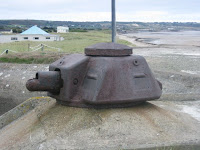




Turn One & Two.
The Prussians were rousing themselves from their encampments whilst Austrian howitzer shells, fired blindly into the darkness, exploded all around. But where were the Austrians? [Turn 1 ended on an immediate tied d20 initiative roll - it seemed the Austrians were waiting for more of their flank columns to get into position before beginning the attack. I love Piquet - a surprise every time).
At the first spark of light they emerged from the early morning mist rushing Hochkirch with Grenzers. They met with mixed results. On the right they were counterattacked by Prussians around the church - it was madness and folly - the Prussians were butchered by these shrieking Balkan peasants. On the left, a sharp volley from the Prussian grenadiers and blasts of canister stopped them in their tracks. Elsewhere the Prussians were at a loss as to where the next attack would fall; but most tried to make their way towards Hochkirch. The first Austrian flanking columns arrived (#1 & 2). The Prussians in the north broke camp and assembled into march column to march south west, and then, with the battle for Hochkirch in full swing, it was turn three (another early tied d20 roll).




Turn Three and Four
No sooner had the Prussians in the north sector of the field started their march, the Austrians began to arrive en-masse on their sector (columns 4, 5, 6 followed by the last and most tardy #3) Arenberg's infantry deployed out of column of battalions into line of battalions (the first move arrival method worked even better than I had imagined - perfect!).
In the south the action around Hochkirch was fierce. The Prussian's hastily organised counter attack to retake the area around the church was coming under murderous fire from the Grenz, whose officers had finally managed to rally them (they had failed to find cards to advance through the village in turn 2 and 3) following their victory over its defenders and move on to the northern side of Hochkirch. In the western sector of Hochkirch the Prussian grenadiers and guns were holding their own - culling the Austrians facing them in their droves - but failing to completely remove the threat (no matter how many the Prussians killed they could not get them to fail morale challenges - the Austrians were aided by having drawn an Up1 to infantry morale in their morale card draw). But then, woe worth the day, Keith fell; the Austrian grenadiers rushed the guns and took the ground for which they fought gallantly to the last. Kieth's counter attack was on the point of collapse.
To the west there was inactivity. The Austrians were keen to await events around Hochkirch whilst Zieten's cavalry awaited firm orders (the Prussian could not draw a cavalry move card if their life depended on it - and it did).
Back in the north the Prussian grenadiers and guns retook their former position and awaited their flanking / supporting cavalry to be recalled. They were too late. Buccow's cavalry had made its way onto their northern flank and charged before any meaningful response could be made. The Austrian cavalry made a series of charges, down the grenadiers flank, rolling them up one by one. But then, miracle of miracles, the final units of grenadiers managed to hold; they drove off the Austrian cavalry with very heavy losses - Buccow's force was spent, and the Prussians sent helter-skelter to the rear rallied and retook their former positions.
Turn five.
Around Hochkirch the battle raged on. Here the Austrian grenadiers tried to dislodge their counterparts, in the western sector of Hochkirch, but were driven off in disorder and taken in the flank by Zietens cuirassier which now stood ready to countercharge any further Austrians daring to cross the earthworks.
Just to the east of Hochkirch the Prussians were now massing a new attack to retake the church area.
In the north, the Prussians cavalry had now managed to take up an advantageous position from which it could try and make an enveloping move of its own.
So we leave the first part of the story with five and a half turns left to go and the Prussians holding on by their fingernails. Having not taken the option to withdraw the Prussians only have one hope left - to attack in the north and, with what remains of that force, march south to the relief of Hochkirch, they have 1 morale point remaining - the Austrians have 27. For the Prussians it's time to do, die and keep going.

























































